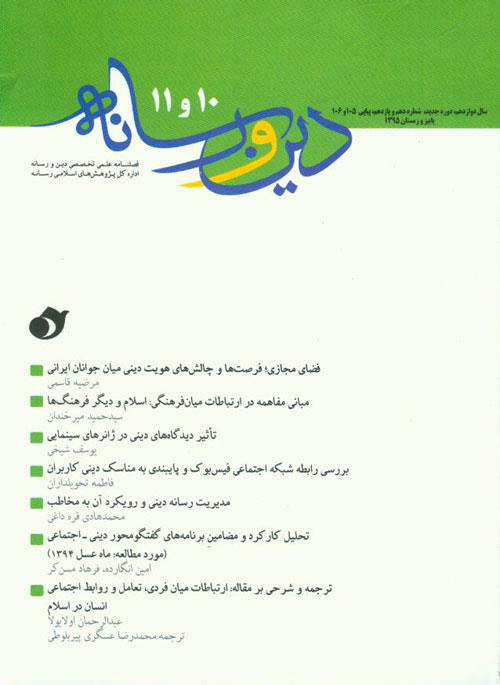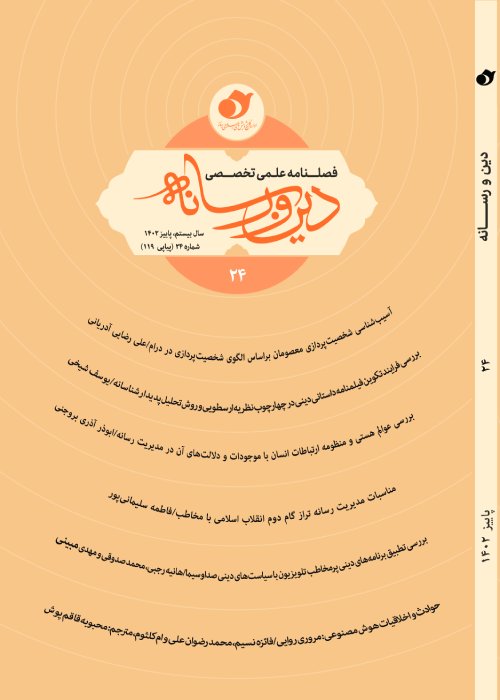فهرست مطالب

فصلنامه دین و رسانه
سال دوازدهم شماره 10 (پاییز و زمستان 1395)
- 152 صفحه،
- تاریخ انتشار: 1396/04/10
- تعداد عناوین: 7
-
Page 7
religious identity in the life of every individual has a very important role today with the spread of information and communication technologies, particularly the emergence of a phenomenon called the virtual space. identity means "who is" that looked fundamental factor in social identities, human interactions with each other and in the form of face-to-face and in a social environment, but the identity in the virtual space Otherwise defined, particularly social networks like Facebook and increased use of the Iranian young population, both to the authorities and the people of Iran has become a concern. The purpose of this article is to examine the consequences of the virtual space on the religious identity of the Iranian youth. The assumption is that the virtual space with diminishing the importance of religious traditions and its components, lays down the religious identity crisis between the Iranian youth. Methodology, exploitation of theoretical arguments associated with the identity and the virtual space and relies on some empirical evidence of research, including research survey, conducted. In this article, first,identity and religious identity and virtual space are defined, then have been investigated the challenges and opportunities of religious identity in cyberspace pointed out in the end, and also the opportunities and threats from the religious identity of the Iranian users, according to some of the results of the investigations conducted among young people in Iran today. the results of the studies and findings indicate that the presence of more in cyberspace, the level of the religious identity of the Iranian youth is weakening associated with the assumption of this article.
Keywords: identity, cyberspace, religious identity, Facebook, Iranian young users -
Page 27
Finding a basic to understanding within intercultural communication aimed to an invitation to Islam and promoting the truth has been a priority in Islam; where you can find at least in one side of the communication an individual or individuals who are part of an Islamic culture. A descriptive-analytical study shows that to obtain this goal one should study different levels of a culture or its infrastructures. This unique and basic infrastructure is called world-view. Classification of intercultural communications based on their relationship with Islamic worldview can be done in different ways: intercultural communication based on Islamic worldview; intercultural communication based on Islamic worldview by cultures based on other religions‟ worldviews; intercultural communication based on Islamic worldview by cultures based on secular worldview. What is important in different types of intercultural communication is a foundation for understanding. In different types, this is common speech or common concepts; where you see some similarities in Islamic worldview, you can find a foundation for understanding and where there are no common concepts, one must rely on common oral knowledge among people from different cultures and recreate common concepts.
Keywords: intercultural communication, levels of culture, worldview, religious culture, face to face understandings -
Page 39
This paper aims to examine the current capacity of different Film genres in general, and four genres in specific (autobiography, noir, crime-action, and science-fiction) to convey religious concepts. This research is framed within a neo-formalistic analysis of films. Findings show that: while autobiography has two limitations (the importance of the main character for character modeling, adherence to reality of issues or time periods of the film story) and crime-action faces five limitations (action, presenting and solving interesting puzzles, social realism, the challenge of leaking the whole story due to rigid regulations and official sensibilities, improving the relationship between citizens and law enforcement forces), both enjoy an acceptable capacity to convey religious concepts in all three levels of anthropology, ontology, and epistemology. However, Noir with five limitations (character limitation, theme/narrative limitation, time/space limitation, fatalism by a dark ending, existentialism philosophy, and a kind of individual spirituality) and science-fiction with three limitations (unknown or imaginary future, technologic and scientific developments of human society, the triumph of pessimism about the future of human beings or so called apocalyptic view) are so much coherent in three levels of anthropology, ontology, and epistemology so that there is no specific capacity for presenting religious concepts .
Keywords: Genre, Religion, anthropology, ontology, epistemology -
Page 66
The aim is to recognize the relation between using Facebook and fidelity to religious rites. The research method is Stratified random sampling. The statistical society includes 1153 persons of Tehran-central and Damavand Science and Research Section of Islamic Azad University BA and MA students educating Social communication field during the second term of 1392-93. The main tool of the research was a questionnaire which its exterior validity has been approved by the respondents and its content validity has been done by the specialists. The reliability for different parts was calculated by Cronbach's alpha coefficients. This coefficient was estimated equal to 0.67 which relates a suitable reliability. The resultant information through SPSS software studied in two descriptive and analytic parts. It showed a meaningful relation between the research hypothesis and fidelity to religious rites of users in terms of duration, amount, taking part, activity, motivation, aim and type of using Facebook. It showed no meaningful relation in terms of gender.
Keywords: Social Network -
Page 83
Choosing an appropriate approach toward audiences by media decision-makers and producers is one of the most issues in media management. Media managers must recognize their relation with the audience so much so that they act aptly and coherent in their productions. In audience literature there are three opinions regarding this relationship: prescriptive, customer oriented, and friend oriented. Applying a descriptive-analytical method, this research tries to briefly explain these approaches and distinguish their relation with divine teachings and present the acceptable approach for a religious media. Findings show that the first two approaches are not in line with Islamic teachings; friend oriented approach is supported by religious teachings .
Keywords: management, religious media, audience, friend-oriented, Islam -
Page 104
Mah-e-Asal is a compound live talk show which is broadcasted for years during Ramadan. As a religious-social talk show, it is broadcasted before Iftar time. The guests are usually those with social and financial problems and they talk about their life and experiences. Compound programs may have only one part (including a host and a dialogue) or different parts of a talk show. Host, guest and the subject are the main elements of a talk show. Ehsan Alikhani as the host and producer is the main figure of this show and his interaction with guests is the main part of the show. By applying a qualitative methodology and thematic analysis technique and encoding all episodes of the show (which were broadcasted in 1394), this research aims to find the main implications and functions of Mah-e-Asal and the strategies to improve its religious-social functions .
Keywords: religion, TV, talk shows, Mah-e-Asal, thematic analysis, network of themes, religious themes -
Page 131
This paper seeks to propagate the idea that Islam is a communicative religion. Allah is communicative God Who takes keen interest in the affairs of His creatures. Interpersonal communication, human interaction and societal relationships in Islam are two way processes of sharing ideas and concerns in open and free environments of love and dedication. The paper is a discussion on how Islam deals with every element of the communication process. The paper concludes that society has a duty to work for, preserve and enhance the unity, strength, integrity, tranquillity and development of society through interpersonal communication, human interaction and social relationships.


